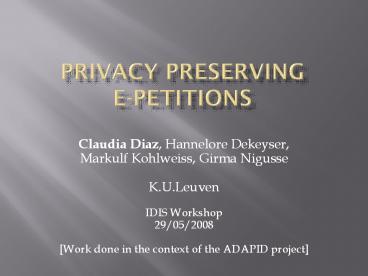privacy preserving e-petitions - PowerPoint PPT Presentation
Title:
privacy preserving e-petitions
Description:
Basic Research project funded by IWT. Focus on security and privacy ... National ID can be user to bootstrap privacy friendlier IDM, while preventing Sybil attacks ... – PowerPoint PPT presentation
Number of Views:93
Avg rating:3.0/5.0
Title: privacy preserving e-petitions
1
privacy preserving e-petitions
- Claudia Diaz, Hannelore Dekeyser,
- Markulf Kohlweiss, Girma Nigusse
- K.U.Leuven
- IDIS Workshop
- 29/05/2008
- Work done in the context of the ADAPID project
2
ADAPID
- Advanced applications for e-ID cards
- Basic Research project funded by IWT
- Focus on security and privacy
- Belgian e-ID based on PKI with X509 certificates
- Hard to build privacy friendly applications
- E-Government
- Hard to find applications where anonymity is
arguably necessary
3
Petitions in the physical world
- Formal request addressed to an authority and
signed by numerous individuals - Typically citizens provide
- Unique identifier (name, national ID number)
- Signature
- Verification
- Validating that the signatures correspond to the
identifiers - Discarding multiple/invalid signatures
4
Electronic petitions
- Benefits of going electronic
- Many resources are needed in order to physically
collect the signatures - Manual signature verification is a costly and
tedious process - Drawbacks
- Easy to cheat (e.g., knowledge of other peoples
name and ID number) - Countermeasures may disenfranchise petition
signers (e.g., IP detection) - Good example of ICT enabling participatory
e-democracy
5
The naive e-petition implementation
- Have users sign the petitions with their e-ID
- Select petition
- Sign using the e-ID (2-factor authentication)
- Validate signature and check that the petition
has not yet been signed with that e-ID - Count (or discard) the signature
- Privacy risks
- Leak sensitive information on political beliefs,
religious inclinations, etc. (this may prevent
some people from signing) - Through unique identifiers, petition signatures
can be linked to other data
6
e-petition requirements
- Basic requirements
- Authentication citizen is who claims to be
(i.e., no impersonation) - Authorization citizen is entitled to sign (e.g.,
age gt 18) - Integrity, Confidentiality
- Multiple signing prevention
- Verifiability all valid signatures are counted
- Privacy requirements
- Signer anonymity citizen unlinkable to petition
(i.e., not possible to identify who are the
signers)
7
Anonymous credential protocols
- Active area of research in cryptography
- They rely on cryptographic protocols and
Zero-Knowlege proofs to reduce to the bare
minimum the amount of information disclosed - Flexible protocols, many options possible
- Example
- CI issues a credential to U that encodes Us age
- U can prove to V that his age is above/below a
threshold - V can check that this is certified by CI
- V does not learn Us exact age
8
PKI vs anonymous credentials
PKI
Anonymous credentials
- Signed by a trusted issuer
- Certification of attributes
- Authentication (secret key)
- Double-signing detection
- Data minimization
- Users are anonymous
- Users are unlinkable in different contexts
- Signed by a trusted issuer
- Certification of attributes
- Authentication (secret key)
- Double-signing detection
- No data minimization
- Users are identifiable
- Users can be tracked (Signature linkable to other
contexts where e-ID is used)
9
Architecture
10
Properties
- Only citizens entitled to sign can do so
- Possession of e-ID knowledge of PIN
- Attribute verification (e.g., age, locality)
- One credential per citizen
- Citizens can sign only once (multiple signing is
detectable so that repeated signatures can be
deleted) - Collusion of credential issuer and e-Petition
server does not reveal the identity of a signer - Verifiability through publishing the protocol
transcripts
11
Summary and conclusions
- Summary of the paper
- Motivation for privacy preserving e-petitions
- Requirement study
- Introduction to anonymous credentials
- Architectural design combining existing
technologies - Legal issues
- To be added details of the protocols and
implementation - Proof-of-concept
- We can satisfy seemingly contradictory
requirements - Security properties can be achieved without
identifiability - National ID can be user to bootstrap privacy
friendlier IDM, while preventing Sybil attacks
12
Thank you!































![DNA EVIDENCE [SC Rule On DNA Evidence] ACA Nimfa Cuesta Vilches PowerPoint PPT Presentation](https://s3.amazonaws.com/images.powershow.com/3895057.th0.jpg?_=20201020101)